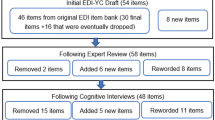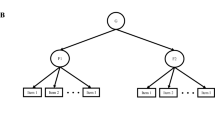Abstract
The lack of sensitive measures suitable for use across the range of functioning in autism spectrum disorder (ASD) is a barrier to treatment development and monitoring. The Emotion Dysregulation Inventory (EDI) is a caregiver-report questionnaire designed to capture emotional distress and problems with emotion regulation in both minimally verbal and verbal individuals. The first two phases of the EDI’s development are described, including: (1) utilizing methods from the Patient-Reported Outcomes Measurement Information System (PROMIS®) project to develop the item pool and response options; and (2) assessment of the EDI in psychiatric inpatients with ASD. The results suggest that the EDI captures a wide range of emotion dysregulation, is sensitive to change, and is not biased by verbal or intellectual ability.




Similar content being viewed by others
References
Aldao, A., Nolen-Hoeksema, S., & Schweizer, S. (2010). Emotion-regulation strategies across psychopathology: A meta-analytic review. Clinical Psychology Review, 30, 217–237.
Alwin, D. F., & Krosknick, J. A. (1991). The reliability of survey attitude measurement: The influence of question and respondent attributes. Sociological Methods Research, 20(1), 139–181.
American Psychiatric Association. (2013). Diagnostic and statistical manual of mental disorders, 5th edition: DSM-5. Washington, DC: American Psychiatric Association.
Arnold, L. E., Vitiello, B., McDougle, C., Scahill, L., Shah, B., Gonzalez, N. M., & Cronin, P. (2003). Parent-defined target symptoms respond to risperidone in RUPP autism study: Customer approach to clinical trials. Journal of the American Academy of Child & Adolescent Psychiatry, 42, 1443–1450.
Bearss, K., Taylor, C. A., Aman, M. G., Whittemore, R., Lecavalier, L., Miller, J., & Scahill, L. (2015). Using qualitative methods to guide scale development for anxiety in youth with autism spectrum disorder. Autism. doi:10.1177/1362361315601012.
Cella, D., Riley, W., Stone, A., Rothrock, N., Reeve, B., Yount, S., & Cook, K. (2010). The patient-reported outcomes measurement information system (PROMIS®) developed and tested its first wave of adult self-reported health outcome item banks: 2005–2008. Journal of Clinical Epidemiology, 63, 1179–1194.
Cella, D., Yount, S., Rothrock, N., Gershon, R., Cook, K., Reeve, B., & Rose, M. (2007). The patient-reported outcomes measurement information system (PROMIS®): Progress of an NIH Roadmap cooperative group during its first two years. Medical Care ,45 (5 Suppl 1), S3–S11.
Christensen, D. L., Baio, J., Braun, K. V. N., Bilder, D., Charles, J., Constantino, J. N., et al. (2016). Prevalence and characteristics of autism spectrum disorder among children aged 8 years—Autism and developmental disabilities monitoring network, 11 sites, United States, 2012. MMWR Surveillance Summaries, 65(3), 1–23. doi:10.15585/mmwr.ss6503a1.
Croen, L. A., Najjar, D. V., Ray, G. T., Lotspeich, L., & Bernal, P. (2006). A comparison of health care utilization and costs of children with and without autism spectrum disorders in a large group-model health plan. Pediatrics, 118(4), e1203–e1211.
Daniels, A. M., Rosenberg, R. E., Anderson, C., Law, J. K., Marvin, A. R., & Law, P. A. (2012). Verification of parent-report of child autism spectrum disorder diagnosis to a web-based autism registry. Journal of Autism and Developmental Disorders, 42, 257–265.
DeWalt, D. A., Rothrock, N., Yount, S., & Stone, A. A. (2007). Evaluation of item candidates: The PROMIS qualitative item review. Medical Care ,45(5 Suppl 1), S12–S21.
Farchione, T. J., Fairholme, C. P., Ellard, K. K., Boisseau, C. L., Thompson-Hollands, J., Carl, J. R., & Barlow, D. H. (2012). Unified protocol for transdiagnostic treatment of emotional disorders: A randomized controlled trial. Behavior Therapy, 43, 666–678.
Hamleton, R. (1991). Fundamentals of item response theory. In F. Lord (Ed.), Applications of item response theory to practical testing problems. New Jersey: Lawrence Erlbaum.
IBM. (2015). SPSS statistics for windows: Version 23. Armonk, NY: IBM Corporation.
Irwin, D. E., Varni, J. W., Yeatts, K., & DeWalt, D. A. (2009). Cognitive interviewing methodology in the development of a pediatric item bank: A patient reported outcomes measurement information system (PROMIS) study. Health and Quality of Life Outcomes ,7(3). doi:10.1186/1477-7525-7-3.
Kerns, C. M., Kendall, P. C., Berry, L., Souders, M. C., Franklin, M. E., Schultz, R. T., & Herrington, J. (2014). Traditional and atypical presentations of anxiety in youth with autism spectrum disorder. Journal of Autism and Developmental Disorders, 44, 2851–2861.
Lartseva, A., Dijkstra, T., & Buitelaar, J. K. (2015). Emotional language processing in autism spectrum disorders: A systematic review. Frontiers in Human Neuroscience, 8, 1–24.
Leyfer, O. T., Folstein, S. E., Bacalman, S., Davis, N. O., Dinh, E., Morgan, J., et al. (2006). Comorbid psychiatric disorders in children with autism: Interview development and rates of disorders. Journal of Autism and Developmental Disorders, 36, 849–861.
Lord, C., Rutter, M., DiLavore, P. C., Risi, S., Gotham, K., & Bishop, S. (2012). Autism diagnostic observation schedule: ADOS-2. Torrance, CA: Western Psychological Services.
Magnuson, K. M., & Constantino, J. N. (2011). Characterization of depression in children with autism spectrum disorders. Journal of Developmental and Behavioral Pediatrics, 32, 332–340.
March, J. S. (1997). Manual for the multidimensional anxiety scale for children (MASC). Toronto, ON: Multi-Health Systems.
Mazefsky, C. A. (2015). Emotion regulation and emotional distress in autism spectrum disorder: Foundations and considerations for future research. Journal of Autism and Developmental Disorders, 45, 3405–3408.
McEvoy, P. M., Nathan, P., & Norton, P. J. (2009). Efficacy of transdiagnostic treatments: A review of published outcome studies and future research directions. Journal of Cognitive Psychotherapy, 23(1), 20–33.
NIMH Research Domain Criteria (RDoC) (2013). Retrieved from http://www.nimh.nih.gov/research-funding/rdoc/index.shtml.
Pilkonis, P. A., Choi, S. W., Reise, S. P., Stover, A. M., Riley, W. T., & Cella, D. (2011). Item banks for measuring emotional distress from the patient-reported outcomes measurement information system (PROMIS®): Depression, anxiety, and anger. Assessment, 18, 263–283.
PROMIS® Validity Standards Committee on behalf of the PROMIS® Network. (2012). PROMIS® instrument development and psychometric evaluation scientific standards. 1–72. Retrieved from http://www.nihpromis.org/science/methodology?AspxAutoDetectCookieSupport=1.
Quill, K. A. (1995). Introduction. In K. A. Quill (Ed.), Teaching children with autism: Strategies to enhance communication and socialization (pp. 1–32). New York: Delmar.
Roid, G. H., Miller, L. J., Pomplun, M., & Koch, C. (2013). Leiter international performance scale, third edition: Leiter-3. Wood Dale, IL: Stoelting Co.
Rutter, M., Bailey, A., & Lord, C. (2003). The social communication questionnaire: Manual. Torrance, CA: Western Psychological Services.
Salazar, F., Baird, G., Chandler, S., Tseng, E., O’Sullivan, T., Howlin, P., & Simonoff, E. (2015). Co-occurring psychiatric disorders in preschool and elementary school-aged children with autism spectrum disorder. Journal of Autism and Developmental Disorders, 45, 2283–2294.
Samson, A. C., Huber, O., & Gross, J. J. (2012). Emotion regulation in Asperger’s syndrome and high-functioning autism. Emotion, 12, 659.
Siegel, M., & Gabriels, R. L. (2014). Psychiatric hospital treatment of children with autism and serious behavioral disturbance. Child and Adolescent Psychiatric Clinics of North America, 23(1), 125–142.
Siegel, M., Milligan, B., Chemelski, B., Payne, D., Ellsworth, B., Harmon, J., & Smith, K. A. (2014). Specialized inpatient psychiatry for serious behavioral disturbance in autism and intellectual disability. Journal of Autism and Developmental Disorders, 44, 3026–3032.
Siegel, M., Smith, K.A., Mazefsky, C., Gabriels, R. L., Erickson, C., Kaplan, D., & Santangelo, S. L. for the Autism and Developmental Disorders Inpatient Research Collaborative (ADDIRC). (2015). The autism inpatient collection: Methods and preliminary sample description. Molecular Autism, 6, 61–71.
Tager-Flusberg, H., & Kasari, C. (2013). Minimally verbal school—aged children with autism spectrum disorder: The neglected end of the spectrum. Autism Research, 6, 468–478.
Watson, D., & Clark, L. A. (1992). Affects separable and inseparable: On the hierarchical arrangement of the negative affects. Journal of Personality and Social Psychology, 62, 489–505.
White, S. W., Elias, R., Salinas, C., Capriola, N., Conner, C. M., Asselin, S., et al. (2016). Students with autism spectrum disorder in college: Results from a preliminary mixed methods needs analysis. Research in Developmental Disabilities. doi:10.1016/j.ridd.2016.05.010. .
White, S. W., Lerner, M. D., McLeod, B. D., Wood, J. J., Ginsburg, G. S., Kerns, C., & Compton, S. (2015). Anxiety in youth with and without autism spectrum disorder: Examination of factorial equivalence. Behavior Therapy, 46, 40–53.
Acknowledgments
The authors would like to thank the experts who reviewed drafts of the EDI, including members of the AIC and affiliates at their hospitals, Michael Aman, MD, Shaun Eack, PhD, Nancy Minshew, MD, Donald Oswald, PhD, and Emily Siminoff, MD. The authors are also grateful to the participants who completed the cognitive interviews and the staff at the Center for Excellence in Autism Research (CeFAR, PI Minshew) who made it possible.
Author Contributions
CM conceived of the study, developed the EDI, designed and participated in data collection, performed the analyses, and drafted the manuscript; TD coordinated the study, and participated in data collection, and manuscript revision; MS participated in the design of the study, interpretation, and manuscript revision; SW participated in the design of the study, interpretation, and manuscript revision; LY participated in the design of the study and reviewed the statistical analysis and manuscript; PP participated in the design of the study and revision of the manuscript. All authors read and approved the final manuscript.
Funding
The development of the EDI was initially supported by the INSAR Ritvo-Slifka Award for Innovation in Autism Research (to C.M.) and is currently supported by a grant from the National Institute of Child Health and Human Development (NICHD; R01HD079512 to C.M.). Dr. Mazefsky also received support from NICHD grant K23HD060601 during the early development of the EDI. The Autism Inpatient Collection (AIC) phenotypic database and biorepository is supported by a grant from the Simons Foundation Autism Research Initiative and the Nancy Lurie Marks Family Foundation (SFARI #296318 to M.S.).
Author information
Authors and Affiliations
Consortia
Corresponding author
Ethics declarations
Conflict of Interest
The authors declare they have no conflicts of interest.
Ethical Approval
All procedures performed involving human participants were in accordance with the ethical standards of the institutional research committees where the data was collected and with the 1964 Helsinki declaration and its later amendments or comparable ethical standards. Informed consent was obtained from all individual participants included in this study.
Additional information
The co-investigators of ADDIRC are listed in the Appendix.
Appendix
Appendix
The ADDIRC is made up of the co-investigators: Matthew Siegel, MD (PI) (Maine Medical Center Research Institute; Tufts University), Craig Erickson, MD (Cincinnati Children’s Hospital; University of Cincinnati), Robin L. Gabriels, PsyD (Children’s Hospital Colorado; University of Colorado), Desmond Kaplan, MD (Sheppard Pratt Health System), Carla A. Mazefsky, PhD (Western Psychiatric Institute and Clinic; University of Pittsburgh), Eric M. Morrow, MD, PhD (Bradley Hospital; Brown University), Giulia Righi, PhD (Bradley Hospital; Brown University), Susan L Santangelo, ScD (Maine Medical Center Research Institute; Tufts University), and Logan Wink, MD (Cincinnati Children’s Hospital; University of Cincinnati). Collaborating investigators and staff: Jill Benevides, BS, Carol Beresford, MD, Carrie Best, MPH, Katie Bowen, LCSW, Briar Dechant, BS, Joanne Dixon, PhD, Tom Flis, BCBA, LCPC, Holly Gastgeb, PhD, Angela Geer, BS, Louis Hagopian, PhD, Benjamin Handen, PhD, BCBA-D, Adam Klever, BS, Martin Lubetsky, MD, Kristen MacKenzie, BS, Zenoa Meservy, MD, John McGonigle, PhD, Kelly McGuire, MD, Faith McNeill, BA, Ernest Pedapati, MD, Christine Peura, BA, Joseph Pierri, MD, Christie Rogers, MS, CCC-SLP, Brad Rossman, MA, Jennifer Ruberg, LISW, Cathleen Small, PhD, Kahsi A. Smith, PhD, Nicole Stuckey, MSN, RN, Barbara Tylenda, PhD, Mary Verdi, MA, Jessica Vezzoli, BS, Deanna Williams, BA, and Diane Williams, PhD, CCC-SLP. We gratefully acknowledge the contributions of the coordinating site advisory group: Donald L. St. Germain, MD and Girard Robinson, MD, and our scientific advisory group: Connie Kasari, PhD., Bryan King, MD, James McCracken, MD, Christopher McDougle, MD, Lawrence Scahill, MSN, PhD, Robert Schultz, PhD and Helen Tager-Flusberg, PhD, the input of the funding organizations and the families and children who participated.
Rights and permissions
About this article
Cite this article
Mazefsky, C.A., Day, T.N., Siegel, M. et al. Development of the Emotion Dysregulation Inventory: A PROMIS®ing Method for Creating Sensitive and Unbiased Questionnaires for Autism Spectrum Disorder. J Autism Dev Disord 48, 3736–3746 (2018). https://doi.org/10.1007/s10803-016-2907-1
Published:
Issue Date:
DOI: https://doi.org/10.1007/s10803-016-2907-1




